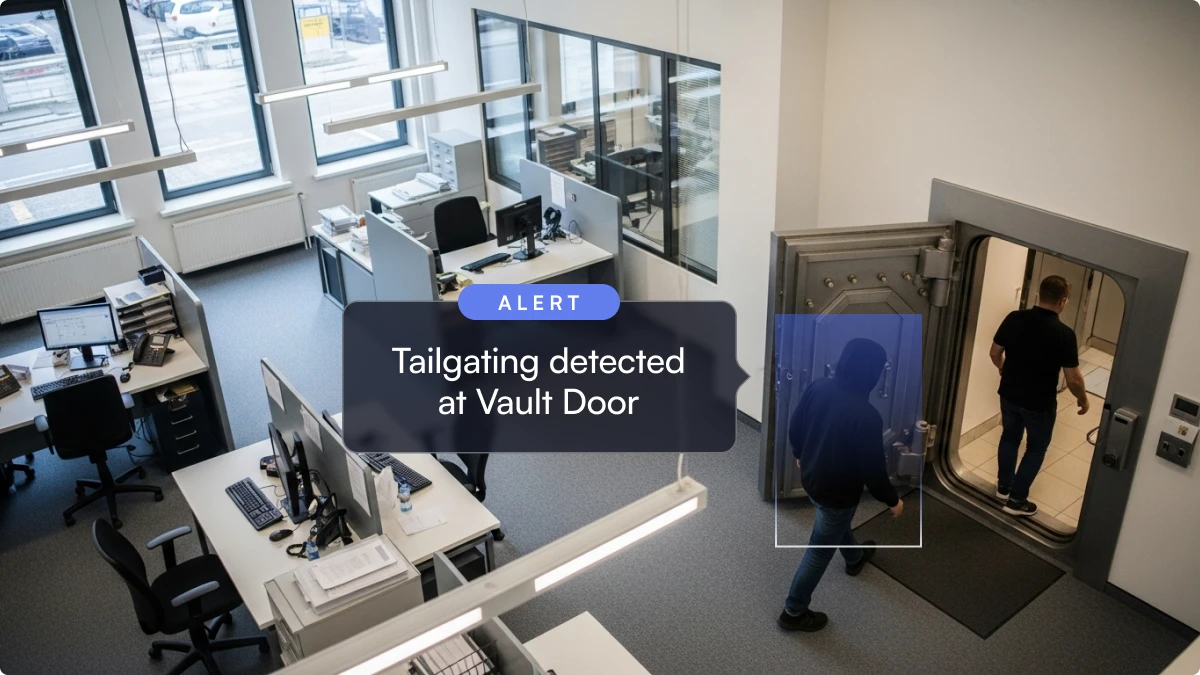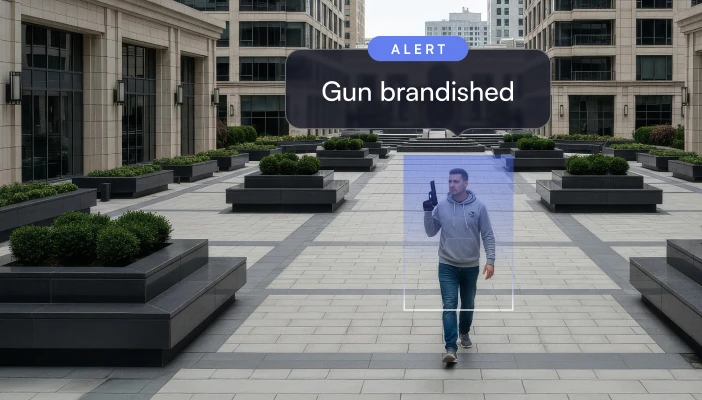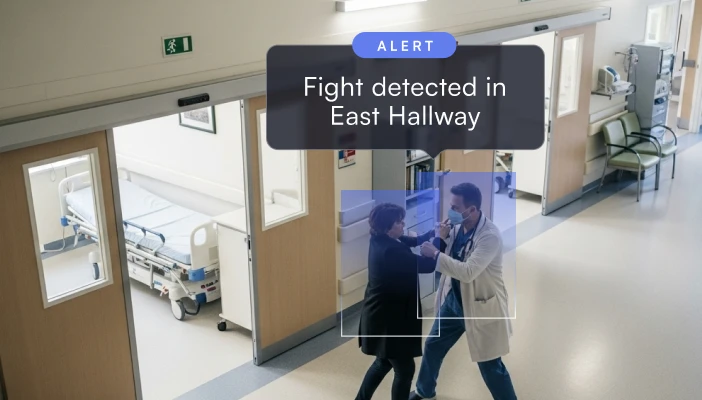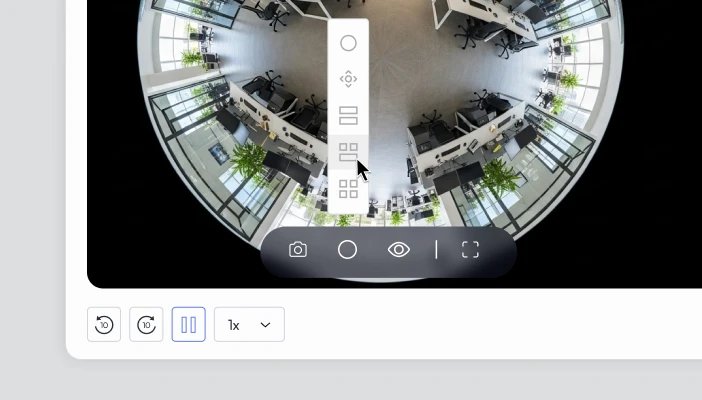Physical security is the backbone of every safe and resilient organization. But in a world of 24/7 operations, sprawling facilities, and sophisticated threats, traditional systems—locks, guards, and passive cameras—are no longer enough.
The challenge isn’t just protecting assets; it’s responding fast enough when something goes wrong. And that’s where artificial intelligence (AI) comes in.
AI turns video cameras and sensors into intelligent security agents that understand context, detect threats, and act instantly. By automating detection and response, AI helps organizations stay one step ahead, protecting people, property, and productivity in real time.
This guide explores what physical security means in the AI era, the most prominent risks organizations face, and how to build a proactive, data-driven security strategy powered by Lumana.
Key Highlights
- AI transforms physical security from passive monitoring to proactive, real-time threat detection and response.
- Intelligent video analytics identify and help prevent intrusion, theft, workplace violence, and environmental hazards.
- Automated alerts, audio/light deterrence, and workflows accelerate response times and reduce false alarms.
- Lumana’s AI-native, hybrid-cloud platform unifies visibility, speeds investigations, and strengthens multi-site safety.
Table of Contents
- What Is Physical Security in the Age of AI?
- Top Physical Security Threats (and How AI Helps)
- How to Identify and Assess Physical Security Threats
- Best Practices for a Modern AI Physical Security Strategy
- How AI Improves Incident Response and Recovery
- How Lumana Elevates Physical Security with AI
What Is Physical Security in the Age of AI?
Physical security protects an organization’s people, facilities, and assets from real-world threats such as intrusion, vandalism, or workplace violence. Traditionally, this involved four key stages: deter, detect, delay, and respond.
But the modern landscape demands more. With hundreds of cameras, multiple sites, and ever-changing risks, human monitoring alone can’t keep up.
AI bridges that gap by:
- Analyzing live video feeds and sensor data 24/7
- Recognizing patterns and behavior, not just motion
- Triggering alerts or deterrence actions in real time
- Helping investigators find evidence in seconds, not hours
The result is a smarter, faster, and more scalable approach to safety and incident management, one that evolves continuously as environments change.

Top Physical Security Threats (and How AI Helps)
Every organization faces its own unique mix of risks, but some threats are universal. Here are the most common, and how AI helps detect and prevent them.
Unauthorized Access
Tailgating and stolen credentials often lead to undetected intrusions. AI-powered access monitoring detects unusual movement or multiple people entering with one badge, sending real-time alerts before the threat escalates.
Theft and Vandalism
AI systems don’t just record theft, they predict it. By detecting loitering, object removal, or after-hours movement, AI can automatically activate deterrents, such as audio warnings or lights, and alert staff instantly.
Workplace Violence
AI recognizes signs of aggression, crowd surges, or erratic movement patterns, helping security teams intervene before violence occurs. This proactive visibility keeps employees and visitors safer.
Insider Threats
Employees or contractors with access can, unintentionally or deliberately, create risk. AI identifies abnormal behavior such as repeated entry into restricted zones or unusual access times, prompting follow-up before damage is done.
Environmental Hazards
Beyond human threats, AI can detect smoke, flooding, and fire visually, alerting teams seconds before traditional sensors respond. Faster awareness means faster evacuation and damage control.
How to Identify and Assess Physical Security Threats
Visibility is the foundation of strong security. AI enhances that visibility by continuously learning from video and behavioral data. Here’s how it helps you assess and prioritize risk:
- AI-assisted surveillance: Monitors all camera feeds simultaneously, automatically flagging anomalies.
- Contextual search: Type queries like “person jumping fence near loading dock” to instantly locate relevant footage.
- Trend analytics: Detect recurring issues, such as repeat trespassing and frequent false alarms, and optimize prevention.
- Predictive insights: Identify high-risk time periods or locations based on historical data.
With these capabilities, organizations move from reactive incident management to proactive risk prediction.
Best Practices for a Modern AI Physical Security Strategy
A strong AI security strategy blends proven fundamentals with intelligent automation.
1. Integrate AI Video Security
Replace passive cameras with AI-enabled systems that detect multiple event types—from trespassing to smoke—ensuring immediate, accurate alerts.
2. Unify Video and Access Control
Link doors, badges, and cameras so every entry event has visual confirmation. AI correlation filters out false positives and flags true anomalies.
3. Strengthen Perimeter Protection
Combine traditional barriers with AI detection for fence climbing, loitering, or vehicle intrusion. AI’s ability to adapt to lighting and weather conditions ensures continuous protection.
4. Automate Deterrence and Response
Define AI-triggered workflows—such as playing an audio warning, flashing lights, or locking doors—so threats are neutralized instantly without manual intervention.
5. Simplify Investigations
Use natural-language video search to find incidents in seconds (“show person entering west door after 9 PM”). AI indexing replaces manual scrubbing with instant results.
6. Monitor and Optimize
AI dashboards display incident trends, false alarm rates, and response times—helping leaders refine strategy and prove ROI.

How AI Improves Incident Response and Recovery
When incidents happen, speed and accuracy matter most. AI accelerates every stage of the response cycle:
- Detection: Continuous monitoring surfaces genuine risks immediately.
- Verification: AI agents and human operators confirm severity in seconds.
- Response: Automated alerts mobilize staff and initiate emergency workflows.
- Investigation: Smart Search reconstructs timelines across multiple cameras.
- Recovery: Analytics reveal root causes to prevent recurrence.
Organizations that use AI move from reacting after the fact to preventing incidents before impact—reducing downtime, liability, and loss.
How Lumana Elevates Physical Security with AI
Lumana brings the power of AI to physical security. Our AI-native, hybrid-cloud platform turns any IP camera into an intelligent sensor capable of real-time understanding and action.
With Lumana, organizations can:
- Detect intrusions, hazards, or violence in sub-second timeframes
- Automate deterrence with lights, audio, or emergency workflows
- Instantly search video using natural-language queries
- Analyze operational patterns with custom AI dashboards
- Scale protection effortlessly with camera-agnostic flexibility
From warehouses to hospitals to campuses, Lumana helps organizations prevent incidents before they happen, unify visibility, and transform video data into actionable intelligence.
The Future of Physical Security Is Intelligent
The evolution of physical security isn’t about replacing people; it’s about empowering them with smarter tools.
AI enables faster detection, more accurate decisions, and fewer false alarms, turning security teams into proactive protectors instead of reactive responders.
By integrating AI into your physical security strategy, you gain not only better protection but also greater awareness, resilience, and confidence.
Ready to build your AI-driven security strategy?
Request a demo and see how Lumana transforms physical security into real-time intelligence.
Discover the power of AI video security
Related Articles
Product news
Oct 29, 2025
October Product Update: AI-Powered Gun Brandished Detection
Workplace safety
Oct 23, 2025
AI Video Security in Healthcare: A Smarter Path to Safer, More Efficient Facilities
Security management
Oct 17, 2025
The Most Advanced Fisheye Camera Experience — Only on Lumana
Sign up for the Webinar
Submitted information will be used in accordance with our Privacy Policy.
Physical security is the backbone of every safe and resilient organization. But in a world of 24/7 operations, sprawling facilities, and sophisticated threats, traditional systems—locks, guards, and passive cameras—are no longer enough.
The challenge isn’t just protecting assets; it’s responding fast enough when something goes wrong. And that’s where artificial intelligence (AI) comes in.
AI turns video cameras and sensors into intelligent security agents that understand context, detect threats, and act instantly. By automating detection and response, AI helps organizations stay one step ahead, protecting people, property, and productivity in real time.
This guide explores what physical security means in the AI era, the most prominent risks organizations face, and how to build a proactive, data-driven security strategy powered by Lumana.
Key Highlights
- AI transforms physical security from passive monitoring to proactive, real-time threat detection and response.
- Intelligent video analytics identify and help prevent intrusion, theft, workplace violence, and environmental hazards.
- Automated alerts, audio/light deterrence, and workflows accelerate response times and reduce false alarms.
- Lumana’s AI-native, hybrid-cloud platform unifies visibility, speeds investigations, and strengthens multi-site safety.
Table of Contents
- What Is Physical Security in the Age of AI?
- Top Physical Security Threats (and How AI Helps)
- How to Identify and Assess Physical Security Threats
- Best Practices for a Modern AI Physical Security Strategy
- How AI Improves Incident Response and Recovery
- How Lumana Elevates Physical Security with AI
What Is Physical Security in the Age of AI?
Physical security protects an organization’s people, facilities, and assets from real-world threats such as intrusion, vandalism, or workplace violence. Traditionally, this involved four key stages: deter, detect, delay, and respond.
But the modern landscape demands more. With hundreds of cameras, multiple sites, and ever-changing risks, human monitoring alone can’t keep up.
AI bridges that gap by:
- Analyzing live video feeds and sensor data 24/7
- Recognizing patterns and behavior, not just motion
- Triggering alerts or deterrence actions in real time
- Helping investigators find evidence in seconds, not hours
The result is a smarter, faster, and more scalable approach to safety and incident management, one that evolves continuously as environments change.

Top Physical Security Threats (and How AI Helps)
Every organization faces its own unique mix of risks, but some threats are universal. Here are the most common, and how AI helps detect and prevent them.
Unauthorized Access
Tailgating and stolen credentials often lead to undetected intrusions. AI-powered access monitoring detects unusual movement or multiple people entering with one badge, sending real-time alerts before the threat escalates.
Theft and Vandalism
AI systems don’t just record theft, they predict it. By detecting loitering, object removal, or after-hours movement, AI can automatically activate deterrents, such as audio warnings or lights, and alert staff instantly.
Workplace Violence
AI recognizes signs of aggression, crowd surges, or erratic movement patterns, helping security teams intervene before violence occurs. This proactive visibility keeps employees and visitors safer.
Insider Threats
Employees or contractors with access can, unintentionally or deliberately, create risk. AI identifies abnormal behavior such as repeated entry into restricted zones or unusual access times, prompting follow-up before damage is done.
Environmental Hazards
Beyond human threats, AI can detect smoke, flooding, and fire visually, alerting teams seconds before traditional sensors respond. Faster awareness means faster evacuation and damage control.
How to Identify and Assess Physical Security Threats
Visibility is the foundation of strong security. AI enhances that visibility by continuously learning from video and behavioral data. Here’s how it helps you assess and prioritize risk:
- AI-assisted surveillance: Monitors all camera feeds simultaneously, automatically flagging anomalies.
- Contextual search: Type queries like “person jumping fence near loading dock” to instantly locate relevant footage.
- Trend analytics: Detect recurring issues, such as repeat trespassing and frequent false alarms, and optimize prevention.
- Predictive insights: Identify high-risk time periods or locations based on historical data.
With these capabilities, organizations move from reactive incident management to proactive risk prediction.
Best Practices for a Modern AI Physical Security Strategy
A strong AI security strategy blends proven fundamentals with intelligent automation.
1. Integrate AI Video Security
Replace passive cameras with AI-enabled systems that detect multiple event types—from trespassing to smoke—ensuring immediate, accurate alerts.
2. Unify Video and Access Control
Link doors, badges, and cameras so every entry event has visual confirmation. AI correlation filters out false positives and flags true anomalies.
3. Strengthen Perimeter Protection
Combine traditional barriers with AI detection for fence climbing, loitering, or vehicle intrusion. AI’s ability to adapt to lighting and weather conditions ensures continuous protection.
4. Automate Deterrence and Response
Define AI-triggered workflows—such as playing an audio warning, flashing lights, or locking doors—so threats are neutralized instantly without manual intervention.
5. Simplify Investigations
Use natural-language video search to find incidents in seconds (“show person entering west door after 9 PM”). AI indexing replaces manual scrubbing with instant results.
6. Monitor and Optimize
AI dashboards display incident trends, false alarm rates, and response times—helping leaders refine strategy and prove ROI.

How AI Improves Incident Response and Recovery
When incidents happen, speed and accuracy matter most. AI accelerates every stage of the response cycle:
- Detection: Continuous monitoring surfaces genuine risks immediately.
- Verification: AI agents and human operators confirm severity in seconds.
- Response: Automated alerts mobilize staff and initiate emergency workflows.
- Investigation: Smart Search reconstructs timelines across multiple cameras.
- Recovery: Analytics reveal root causes to prevent recurrence.
Organizations that use AI move from reacting after the fact to preventing incidents before impact—reducing downtime, liability, and loss.
How Lumana Elevates Physical Security with AI
Lumana brings the power of AI to physical security. Our AI-native, hybrid-cloud platform turns any IP camera into an intelligent sensor capable of real-time understanding and action.
With Lumana, organizations can:
- Detect intrusions, hazards, or violence in sub-second timeframes
- Automate deterrence with lights, audio, or emergency workflows
- Instantly search video using natural-language queries
- Analyze operational patterns with custom AI dashboards
- Scale protection effortlessly with camera-agnostic flexibility
From warehouses to hospitals to campuses, Lumana helps organizations prevent incidents before they happen, unify visibility, and transform video data into actionable intelligence.
The Future of Physical Security Is Intelligent
The evolution of physical security isn’t about replacing people; it’s about empowering them with smarter tools.
AI enables faster detection, more accurate decisions, and fewer false alarms, turning security teams into proactive protectors instead of reactive responders.
By integrating AI into your physical security strategy, you gain not only better protection but also greater awareness, resilience, and confidence.
Ready to build your AI-driven security strategy?
Request a demo and see how Lumana transforms physical security into real-time intelligence.








